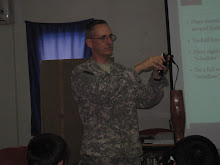I think today was the apex of our training here at Ft Riley with the exception of the live fire weapons training.

Saturday we spent in classes and practical exercises on advanced medical care in the field. We reviewed all of the currently used and old or NATO medical dressings and interventional kits. The Army has some computerized manikins for training use. The highlight of the training was placing IV's in each other in dark.(not completely, but definitely not enough light to actually see a vein)
The trauma validation came first thing this morning. We were individually brought in with a medical kit and presented with a casualty to treat in the dark with smoke and loudspeakers blaring combat audio. A headlamp was basically required to get anything done. It is a pretty adventurous list of things that had to be accomplished. Required interventions included:
1 Tourniquets place tight enough to stop gushing femoral arteries to amputated leg.
2. Placement of a second tourniquet to the other leg.
3. Place a Nasopharngeal Airway.
4. Place a seal over a sucking chest wound with tape on all 4 sides.
5. Needle decompression of tension pneumothorax.
6. Placement of an IV in noninjured arm. (I almost forgot to remove the tourniquet to the arm).
7. Placement of a Combi Tube to secure the airway.
8. Placement of a FastOne IntraOsseous for vascular access to provide Hextend after the IV gets "pulled out" (sterile swipe counted off and made you a NoGo)
9. Perform a Cricothyroidotomy. ( Once again sterility counted)
This is a lot to do in 15 min by yourself, especially in the dark with all manner of sound distractions. A few of our team had to repeat the process until they got it done. Picture #1 the trauma validation, #2 the aftermath.

This was only the warm up though. We were split into 8 man teams and assigned a leader, radio operator and medic. We were briefed that we would need to extract casulties under fire, remove them to a safe area, then treat to stabilize, 9 line MEDEVAC request and then transport them to the awaiting helicopters. Both our team and the "enemy' were armed with paintball guns. A large arty simulator flash bang started the exercise. We cleared 3 barricades and made it to the HMMWV in good order, but the extraction was tough. I was inside the vehicle working to get the patients out. Each dummy weighed 185 lbs and then had the stardard body armor adding up tot 40 more pounds. I was pretty exhaused by the time I pushed the last casualty out of the HHMWV. I would probably still be stuck in there if a teamate had not held the armored door open for me.( the HMMWV was tilted).

Thankfully the rest of the team had applied tourniquets to the casualties by the time I got out of the vehicle. We had two litters, so the last mud covered wet casualty we moved with a modified drag. We had to transport through a tunnel and over a wall. The whole time smoke and flashbangs were going off. The training cadre also got close and personal with many unhelpful comments - just to add to the confusion.
Then we moved inside to repeat our tramua validation as a team for two of the casualties. Our Radioman gave the MEDVAC request. We had to quickly transport to the heli site(simulated) and we did a hot wash after action. The funniest part was watching the videos of all 3 teams and seeing what worked and what did not.

It was well put together training which may well save many lives.
My new Army trousers, however, are shredded and purple.

The Thunder Run has linked to this post in the blog post From the Front: 04/28/2009 News and Personal dispatches from the front and the home front.
ReplyDeleteHey BR, missed you this weekend. Keep up the great work out there and I hope we can all get together for the 25th (if not sooner).
ReplyDeleteThis is joint service training? What specialty are the Airmen that are involved? Just curious as I never got to do anything this cool while in the service. Very nice blog by the way, the information is much appreciated. Be safe.
ReplyDeleteDale